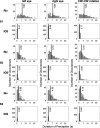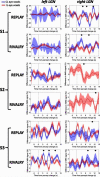Neural Dynamics during Binocular Rivalry: Indications from Human Lateral Geniculate Nucleus
- PMID: 36609303
- PMCID: PMC9840381
- DOI: 10.1523/ENEURO.0470-22.2022
Neural Dynamics during Binocular Rivalry: Indications from Human Lateral Geniculate Nucleus
Abstract
When two sufficiently different stimuli are presented to each eye, perception alternates between them. This binocular rivalry is conceived as a competition for representation in the single stream of visual consciousness. The magnocellular (M) and parvocellular (P) pathways, originating in the retina, encode disparate information, but their potentially different contributions to binocular rivalry have not been determined. Here, we used functional magnetic resonance imaging to measure the human lateral geniculate nucleus (LGN), where the M and P neurons are segregated into layers receiving input from a single eye. We had three participants (one male, two females) and used achromatic stimuli to avoid contributions from color opponent neurons that may have confounded previous studies. We observed activity in the eye-specific regions of LGN correlated with perception, with similar magnitudes during rivalry or physical stimuli alternations, also similar in the M and P regions. These results suggest that LGN activity reflects our perceptions during binocular rivalry and is not simply an artifact of color opponency. Further, perception appears to be a global phenomenon in the LGN, not just limited to a single information channel.
Keywords: binocular rivalry; fMRI; lateral geniculate nucleus; magnocellular; parvocellular.
Copyright © 2023 Yildirim and Schneider.
Conflict of interest statement
The authors declare no competing financial interests.
Figures





Similar articles
-
Eye-specific effects of binocular rivalry in the human lateral geniculate nucleus.Nature. 2005 Nov 24;438(7067):496-9. doi: 10.1038/nature04169. Epub 2005 Oct 23. Nature. 2005. PMID: 16244649 Free PMC article.
-
Binocular response modulation in the lateral geniculate nucleus.J Comp Neurol. 2019 Feb 15;527(3):522-534. doi: 10.1002/cne.24417. Epub 2018 Mar 9. J Comp Neurol. 2019. PMID: 29473163 Free PMC article. Review.
-
Neural correlates of binocular rivalry in the human lateral geniculate nucleus.Nat Neurosci. 2005 Nov;8(11):1595-602. doi: 10.1038/nn1554. Epub 2005 Oct 23. Nat Neurosci. 2005. PMID: 16234812 Free PMC article.
-
Distinct contributions of the magnocellular and parvocellular visual streams to perceptual selection.J Cogn Neurosci. 2012 Jan;24(1):246-59. doi: 10.1162/jocn_a_00121. Epub 2011 Aug 23. J Cogn Neurosci. 2012. PMID: 21861685 Free PMC article.
-
Mapping the primate lateral geniculate nucleus: a review of experiments and methods.J Physiol Paris. 2014 Feb;108(1):3-10. doi: 10.1016/j.jphysparis.2013.10.001. Epub 2013 Nov 21. J Physiol Paris. 2014. PMID: 24270042 Free PMC article. Review.
Cited by
-
Magnocellular-biased interocular integration during onset rivalry in normal vision and binocular imbalance.J Vis. 2025 Aug 1;25(10):8. doi: 10.1167/jov.25.10.8. J Vis. 2025. PMID: 40824263 Free PMC article.
References
-
- Alais D, Blake R (2015) Binocular rivalry and perceptual ambiguity. In: Oxford handbook of perceptual organization (Wagemans J, ed), pp 775–798. New York: Oxford UP.
-
- Blake R (2022) The perceptual magic of binocular rivalry. Curr Dir Psychol Sci 31:139–146. 10.1177/09637214211057564 - DOI
Publication types
MeSH terms
Grants and funding
LinkOut - more resources
Full Text Sources
